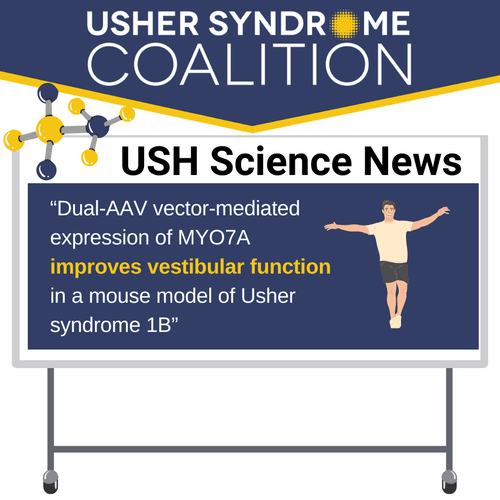Grounded in Science
A balance of research news and well-being for the Usher syndrome community.
We are only 10 weeks away from our next conference! Who else is getting excited? We certainly are! Be sure to follow us on social media to see more conference-related content leading up to the event.
USH Connections Conference | July 19-20, Rochester, NY + Online
Hosted in partnership with the National Technical Institute for the Deaf
Have you joined the Usher Syndrome Coalition Discord Community Server? It’s a safe place for the community to connect with each other. Join here: https://discord.gg/czwHGaDu7W
Research Spotlight
AAVantgarde announces its innovative clinical study design for its lead program in Usher 1B
AAvantgarde is a clinical-stage, Italian-based international biotechnology company with two Adeno-Associated Viral (AAV) vector platforms for large gene delivery. AAV vector platforms use viruses that can be engineered to deliver DNA to target cells (Naso 2017). Typically, AAV vectors are limited because they can accommodate only small genes. AAVantgarde utilizes an AAV dual hybrid program to accommodate the larger-sized MYO7A gene.
At the 9th Annual Retinal Cell and Gene Therapy Innovation Summit held in Seattle on May 3rd, AAVantgarde shared a presentation titled, “Design of a Phase 1/2 clinical trial using a dual vector strategy for the treatment of MYO7A-related Usher syndrome (USH1B).”
This first-in-human clinical study will be called “LUCE-1.” Prof. Francesca Simonelli is the trial’s Principal Investigator.
“I am delighted to be presenting the pre-clinical and clinical activities that paved the way to the design of this first-in-human Phase 1/2 clinical study at the Summit. Through this innovative design, we aim to revolutionize our approach to understanding and treating Usher 1B patients. We are poised to generate robust evidence that will not only advance scientific knowledge, but also directly impact patient care,” said Prof. Francesca Simonelli, Head of Ophthalmology at the University of Campania Luigi Vanvitelli (Naples).
This study aims to provide supporting evidence for the effectiveness and safety of AAVB-081, designed to treat RP caused by MYO7A-related Usher syndrome (USH1B) following previous animal studies that demonstrated improved retinal phenotypes.
Check out our Current USH Research page specific to USH subtype as well as gene-independent therapeutic approaches.
In Case You Missed It: Science News Feature
Dual-AAV vector-mediated expression of MYO7A improves vestibular function in a mouse model of Usher syndrome 1B
August 21, 2023: Usher syndrome type 1B (USH1B) is the most common form of USH Type 1 and is caused by a mutation in the MYO7A gene. USH1B patients are born with profound hearing loss, vestibular dysfunction (balance disorder), and progressive vision loss due to retinitis pigmentosa that begins within the first 10 years of life.
Recent advancements in gene therapy can address a genetic mutation by replacing the defective gene with a healthy copy. Viral vectors such as adeno-associated viruses (AAVs) are commonly used for gene delivery due to their safety (only inducing a mild immune response) and ability to infect a broad range of cells. However, AAVs can only carry (or package) up to 4.4Kb of DNA, and the MYO7A gene is ~6.7Kb. To work around this limitation, researchers at the National Institutes of Health (NIH) and the University of Florida split the healthy copy of MYO7A into two halves and inserted each half into separate AAV vectors for dual gene delivery of each half. When these two separate AAV vectors infect the same cell, the two halves join together to form a complete, healthy copy of the MYO7A gene with full functionality. Injection with dual-AAV delivery of MYO7A into a mouse model of USH1B restored MYO7A gene expression in both the cochlear and vestibular hair cells, leading to improved vestibular function.
What this means for Usher syndrome: Vestibular dysfunction puts USH1B patients at greater risk of falling and injury. Gene therapy treatment using this dual-AAV approach to repair the mutated MYO7A gene shows promise in helping USH1B patients lead safer lives.
For more science news, check out our Science News page, organized by treatment approach and type of Usher syndrome.
DISCLAIMER: The Usher Syndrome Coalition does not provide medical advice nor promote treatment methods. USH Science News is intended to help summarize more complex literature for the community to use at their own discretion.
ON WELL-BEING: Acknowledging stress associated with self-advocacy: A parent and mental health provider perspective
My child has been praised for their self-advocacy skills ever since they were a toddler. We as parents, have been advised that their ability to self-advocate will greatly impact their success in mainstream environments...
USH Life Hack of the Month
(Send your USH life hacks to info@usher-syndrome.org.)
A team of researchers at Massachusetts Eye and Ear developed an app called All_Aboard, which is designed to complement GPS navigation by using auditory cues to guide the user to their destination. The app uses the phone’s camera to detect street signs in order to improve micro-navigation for people who are blind or visually impaired.








